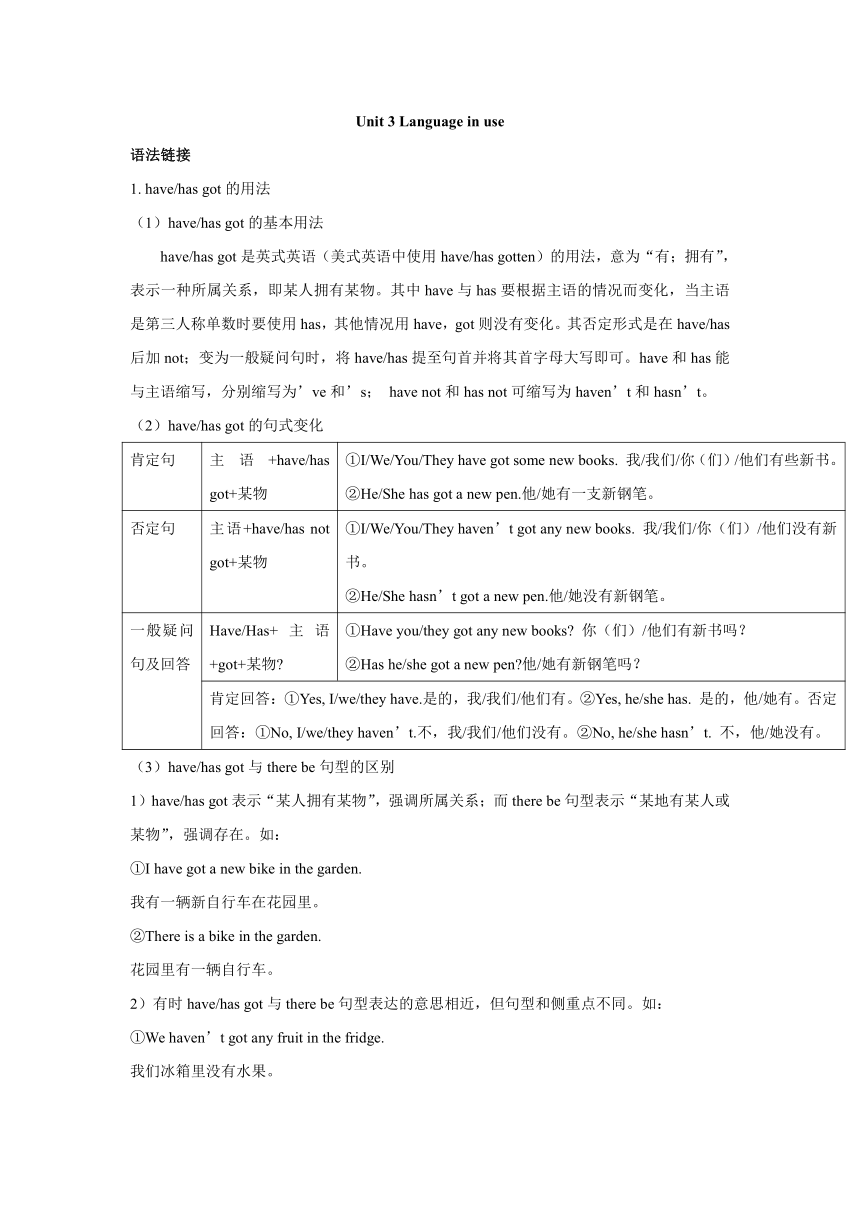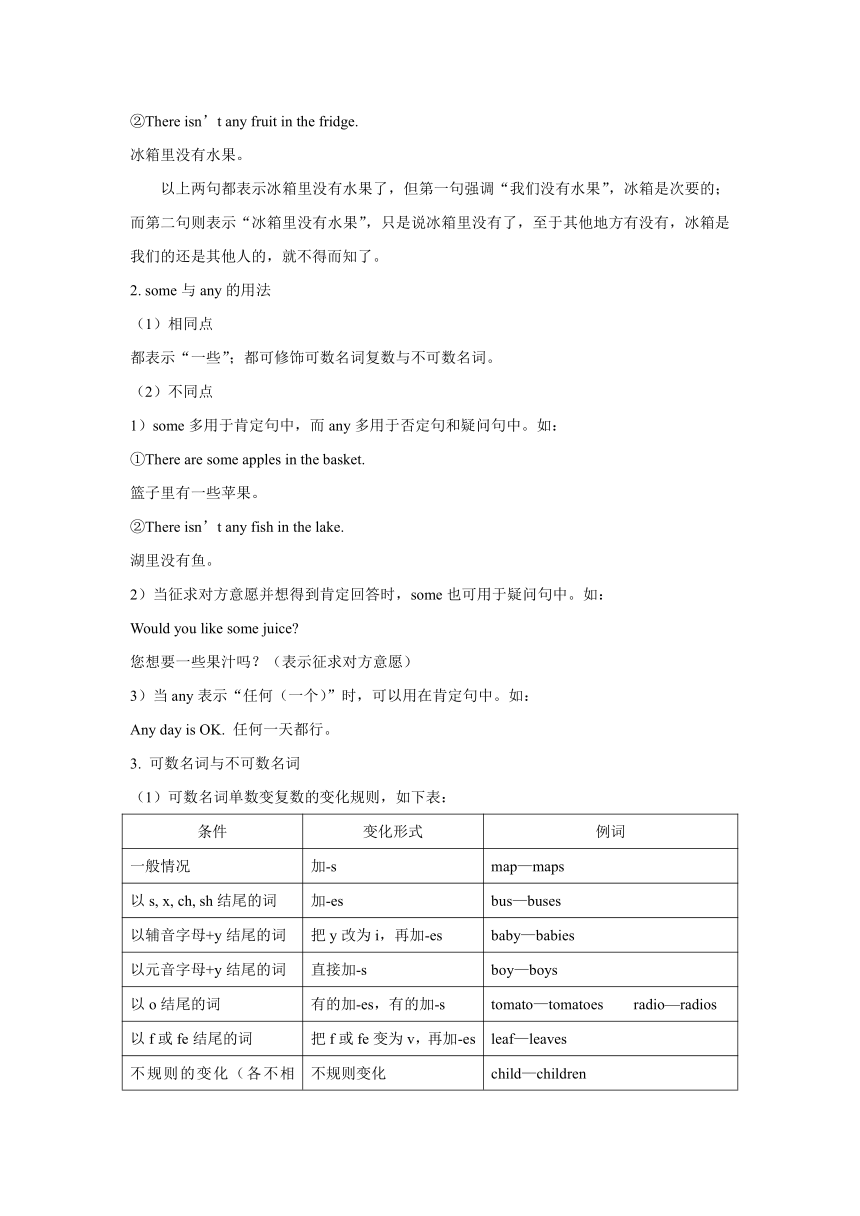外研版英语七年级上册 Module 4 Unit 3 Language in use. 教案
文档属性
| 名称 | 外研版英语七年级上册 Module 4 Unit 3 Language in use. 教案 |  | |
| 格式 | docx | ||
| 文件大小 | 13.8KB | ||
| 资源类型 | 教案 | ||
| 版本资源 | 外研版 | ||
| 科目 | 英语 | ||
| 更新时间 | 2023-06-19 10:53:26 | ||
图片预览


文档简介
Unit 3 Language in use
语法链接
1. have/has got的用法
(1)have/has got的基本用法
have/has got是英式英语(美式英语中使用have/has gotten)的用法,意为“有;拥有”,表示一种所属关系,即某人拥有某物。其中have与has要根据主语的情况而变化,当主语是第三人称单数时要使用has,其他情况用have,got则没有变化。其否定形式是在have/has后加not;变为一般疑问句时,将have/has提至句首并将其首字母大写即可。have和has能与主语缩写,分别缩写为’ve和’s; have not和has not可缩写为haven’t和hasn’t。
(2)have/has got的句式变化
肯定句 主语+have/has got+某物 ①I/We/You/They have got some new books. 我/我们/你(们)/他们有些新书。 ②He/She has got a new pen.他/她有一支新钢笔。
否定句 主语+have/has not got+某物 ①I/We/You/They haven’t got any new books. 我/我们/你(们)/他们没有新书。 ②He/She hasn’t got a new pen.他/她没有新钢笔。
一般疑问句及回答 Have/Has+主语+got+某物 ①Have you/they got any new books 你(们)/他们有新书吗? ②Has he/she got a new pen 他/她有新钢笔吗?
肯定回答:①Yes, I/we/they have.是的,我/我们/他们有。②Yes, he/she has. 是的,他/她有。否定回答:①No, I/we/they haven’t.不,我/我们/他们没有。②No, he/she hasn’t. 不,他/她没有。
(3)have/has got与there be句型的区别
1)have/has got表示“某人拥有某物”,强调所属关系;而there be句型表示“某地有某人或某物”,强调存在。如:
①I have got a new bike in the garden.
我有一辆新自行车在花园里。
②There is a bike in the garden.
花园里有一辆自行车。
2)有时have/has got与there be句型表达的意思相近,但句型和侧重点不同。如:
①We haven’t got any fruit in the fridge.
我们冰箱里没有水果。
②There isn’t any fruit in the fridge.
冰箱里没有水果。
以上两句都表示冰箱里没有水果了,但第一句强调“我们没有水果”,冰箱是次要的;而第二句则表示“冰箱里没有水果”,只是说冰箱里没有了,至于其他地方有没有,冰箱是我们的还是其他人的,就不得而知了。
2. some与any的用法
(1)相同点
都表示“一些”;都可修饰可数名词复数与不可数名词。
(2)不同点
1)some多用于肯定句中,而any多用于否定句和疑问句中。如:
①There are some apples in the basket.
篮子里有一些苹果。
②There isn’t any fish in the lake.
湖里没有鱼。
2)当征求对方意愿并想得到肯定回答时,some也可用于疑问句中。如:
Would you like some juice
您想要一些果汁吗?(表示征求对方意愿)
3)当any表示“任何(一个)”时,可以用在肯定句中。如:
Any day is OK. 任何一天都行。
3. 可数名词与不可数名词
(1)可数名词单数变复数的变化规则,如下表:
条件 变化形式 例词
一般情况 加-s map—maps
以s, x, ch, sh结尾的词 加-es bus—buses
以辅音字母+y结尾的词 把y改为i,再加-es baby—babies
以元音字母+y结尾的词 直接加-s boy—boys
以o结尾的词 有的加-es,有的加-s tomato—tomatoes radio—radios
以f或fe结尾的词 把f或fe变为v,再加-es leaf—leaves
不规则的变化(各不相同,需单独记忆) 不规则变化 child—children
单复数同形 sheep—sheep
(2)可数名词与不可数名词的用法区别
1)可数名词单数可用a或an来修饰。如:an apple, a banana;而不可数名词则要借助一个量词来表达,其结构为“数量+量词+of+不可数名词”。如:a cup of tea, two pieces of paper。
2)可数名词可以用具体的数词来修饰,还可以用many, some, a lot of/lots of, few, a few等来表达数量的多少。如:two trees, some pens;不可数名词前不能直接加数词,但可用some, any, much, a lot of/lots of, little, a little等来修饰。如:some money, much rice, a little water。
3)可数名词常用how many来询问数量的多少,不可数名词则用how much提问。
4)常见的不可数名词:
A. 物质名词,如:milk, money等。
B. 抽象名词,如:health, youth等。
写作解码
【话题呈现】
本模块以“健康的食物”为话题,通过介绍不同的食物,了解哪些是健康的,哪些是不健康的,从而让学生养成良好的饮食习惯,并学会营养配餐。
【佳句荟萃】
①Eat the right food and be healthy.
②Meat is healthy but too much meat is not good for children.
③Cola and candy are very sweet, and too much sugar is bad for you.
④It is important to remember: eat well, stay healthy, and don’t get fat!
⑤Have a good breakfast every morning.
⑥Drink juice, water, tea and milk, not cola.
⑦Eat lots of fruit and vegetables.
【写作任务】
为了保持健康,请写一篇短文来告诉你的同学哪些食物和饮料是健康的,哪些是不健康的。
要点:分出健康和不健康的食物和饮料。
要求:不少于50词。
参考词汇:unhealthy不健康的;should应该
【范文展示】
Many kinds of foods are healthy, but some are unhealthy.
Meat is healthy food. Rice and bread are healthy food. Vegetables and fruit are healthy food. But hamburgers and ice cream are unhealthy food. Milk, juice and water are healthy drinks, but cola is an unhealthy drink.
To stay healthy, we should eat lots of healthy food and drink lots of healthy drinks.
【升格点拨】
1. 食品与饮料类单词的单复数、可数与不可数名词的运用十分准确。
2. 文章切题,符合题意,叙述有条有理,本模块所学佳句运用得非常得体,尤其是提建议的句子,是一篇佳作。
3. healthy, unhealthy掌握得也很好。
语法链接
1. have/has got的用法
(1)have/has got的基本用法
have/has got是英式英语(美式英语中使用have/has gotten)的用法,意为“有;拥有”,表示一种所属关系,即某人拥有某物。其中have与has要根据主语的情况而变化,当主语是第三人称单数时要使用has,其他情况用have,got则没有变化。其否定形式是在have/has后加not;变为一般疑问句时,将have/has提至句首并将其首字母大写即可。have和has能与主语缩写,分别缩写为’ve和’s; have not和has not可缩写为haven’t和hasn’t。
(2)have/has got的句式变化
肯定句 主语+have/has got+某物 ①I/We/You/They have got some new books. 我/我们/你(们)/他们有些新书。 ②He/She has got a new pen.他/她有一支新钢笔。
否定句 主语+have/has not got+某物 ①I/We/You/They haven’t got any new books. 我/我们/你(们)/他们没有新书。 ②He/She hasn’t got a new pen.他/她没有新钢笔。
一般疑问句及回答 Have/Has+主语+got+某物 ①Have you/they got any new books 你(们)/他们有新书吗? ②Has he/she got a new pen 他/她有新钢笔吗?
肯定回答:①Yes, I/we/they have.是的,我/我们/他们有。②Yes, he/she has. 是的,他/她有。否定回答:①No, I/we/they haven’t.不,我/我们/他们没有。②No, he/she hasn’t. 不,他/她没有。
(3)have/has got与there be句型的区别
1)have/has got表示“某人拥有某物”,强调所属关系;而there be句型表示“某地有某人或某物”,强调存在。如:
①I have got a new bike in the garden.
我有一辆新自行车在花园里。
②There is a bike in the garden.
花园里有一辆自行车。
2)有时have/has got与there be句型表达的意思相近,但句型和侧重点不同。如:
①We haven’t got any fruit in the fridge.
我们冰箱里没有水果。
②There isn’t any fruit in the fridge.
冰箱里没有水果。
以上两句都表示冰箱里没有水果了,但第一句强调“我们没有水果”,冰箱是次要的;而第二句则表示“冰箱里没有水果”,只是说冰箱里没有了,至于其他地方有没有,冰箱是我们的还是其他人的,就不得而知了。
2. some与any的用法
(1)相同点
都表示“一些”;都可修饰可数名词复数与不可数名词。
(2)不同点
1)some多用于肯定句中,而any多用于否定句和疑问句中。如:
①There are some apples in the basket.
篮子里有一些苹果。
②There isn’t any fish in the lake.
湖里没有鱼。
2)当征求对方意愿并想得到肯定回答时,some也可用于疑问句中。如:
Would you like some juice
您想要一些果汁吗?(表示征求对方意愿)
3)当any表示“任何(一个)”时,可以用在肯定句中。如:
Any day is OK. 任何一天都行。
3. 可数名词与不可数名词
(1)可数名词单数变复数的变化规则,如下表:
条件 变化形式 例词
一般情况 加-s map—maps
以s, x, ch, sh结尾的词 加-es bus—buses
以辅音字母+y结尾的词 把y改为i,再加-es baby—babies
以元音字母+y结尾的词 直接加-s boy—boys
以o结尾的词 有的加-es,有的加-s tomato—tomatoes radio—radios
以f或fe结尾的词 把f或fe变为v,再加-es leaf—leaves
不规则的变化(各不相同,需单独记忆) 不规则变化 child—children
单复数同形 sheep—sheep
(2)可数名词与不可数名词的用法区别
1)可数名词单数可用a或an来修饰。如:an apple, a banana;而不可数名词则要借助一个量词来表达,其结构为“数量+量词+of+不可数名词”。如:a cup of tea, two pieces of paper。
2)可数名词可以用具体的数词来修饰,还可以用many, some, a lot of/lots of, few, a few等来表达数量的多少。如:two trees, some pens;不可数名词前不能直接加数词,但可用some, any, much, a lot of/lots of, little, a little等来修饰。如:some money, much rice, a little water。
3)可数名词常用how many来询问数量的多少,不可数名词则用how much提问。
4)常见的不可数名词:
A. 物质名词,如:milk, money等。
B. 抽象名词,如:health, youth等。
写作解码
【话题呈现】
本模块以“健康的食物”为话题,通过介绍不同的食物,了解哪些是健康的,哪些是不健康的,从而让学生养成良好的饮食习惯,并学会营养配餐。
【佳句荟萃】
①Eat the right food and be healthy.
②Meat is healthy but too much meat is not good for children.
③Cola and candy are very sweet, and too much sugar is bad for you.
④It is important to remember: eat well, stay healthy, and don’t get fat!
⑤Have a good breakfast every morning.
⑥Drink juice, water, tea and milk, not cola.
⑦Eat lots of fruit and vegetables.
【写作任务】
为了保持健康,请写一篇短文来告诉你的同学哪些食物和饮料是健康的,哪些是不健康的。
要点:分出健康和不健康的食物和饮料。
要求:不少于50词。
参考词汇:unhealthy不健康的;should应该
【范文展示】
Many kinds of foods are healthy, but some are unhealthy.
Meat is healthy food. Rice and bread are healthy food. Vegetables and fruit are healthy food. But hamburgers and ice cream are unhealthy food. Milk, juice and water are healthy drinks, but cola is an unhealthy drink.
To stay healthy, we should eat lots of healthy food and drink lots of healthy drinks.
【升格点拨】
1. 食品与饮料类单词的单复数、可数与不可数名词的运用十分准确。
2. 文章切题,符合题意,叙述有条有理,本模块所学佳句运用得非常得体,尤其是提建议的句子,是一篇佳作。
3. healthy, unhealthy掌握得也很好。
同课章节目录
- Starte
- Module 1 My teacher and my friends
- Module 2 My English lesson
- Module 3 My English book
- Module 4 My everyday life
- Module 1 My classmates
- Unit 1 Nice to meet you.
- Unit 2 I'm Wang Lingling and I'm thirteen years ol
- Unit 3 Language in use.
- Module 2 My family
- Unit 1 Is this your mum?
- Unit 2 These are my parents.
- Unit 3 Language in use.
- Module 3 My school
- Unit 1 There are thirty students in my class.
- Unit 2 The library is on the left of the playgroun
- Unit 3 Language in use.
- Module 4 Healthy food
- Unit 1 We've got lots of apples.
- Unit 2 Is your food and drink healthy?
- Unit 3 Language in use.
- Module 5 My school day
- Unit 1 I love history.
- Unit 2 We start work at nine o'clock.
- Unit 3 Language in use.
- Revision module A
- Module 6 A trip to the zoo
- Unit 1 Does it eat meat?
- Unit 2 The tiger lives in Asia.
- Unit 3 Language in use.
- Module 7 Computers
- Unit 1 How do I write my homework on the computer?
- Unit 2 When do you use a computer?
- Unit 3 Language in use.
- Module 8 Choosing presents
- Unit 1 I always like birthday parties.
- Unit 2 She often goes to concerts.
- Unit 3 Language in use.
- Module 9 People and places
- Unit 1 We're enjoying the school trip a lot.
- Unit 2 They're waiting for buses or trains.
- Unit 3 Language in use.
- Module 10 Spring Festival
- Unit 1 Are you getting ready for Spring Festival?
- Unit 2 My mother's cleaning our houses and sweepin
- Unit 3 Language in use.
- Revision module B
